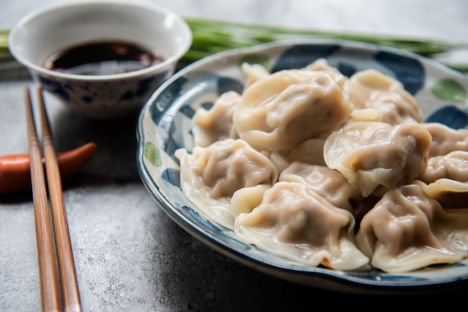
How Britain fell in love with Chinese food
We dig into the history of British-Chinese food, the impact of imported Chinese ingredients like Amoy Soy and the surprising Victorian fondness for soy sauce.
How Britain fell in love with Chinese food
We dig into the history of British-Chinese food, the impact of imported Chinese ingredients like Amoy Soy and the surprising Victorian fondness for soy sauce.
One in three households in the UK owns a bottle of soy sauce – far more than the number who have tinned corned beef or condensed milk, according to a survey by SPAR. Although that might sound surprising, soy sauce has been in England for longer than most people would expect. Soy sauce was used throughout the very first edition of Mrs. Beeton published in 1861, and yet, Chinese home cooking didn’t become widespread in the UK until the end of the 20th century.
The availability in the UK of canned Chinese ingredients like bean sprouts and bamboo shoots began increasing in the 1900s, as Chinese sailors began settling in ports around London and Liverpool. Asian ingredient brand Amoy (then called Amoy Canning) moved its manufacturing from Xiamen to Hong Kong in 1928, which helped soy sauce and canned Chinese foods begin to travel the world. The arrival of bottled and tinned Chinese ingredients alongside people with the skills to import and cook the food, meant that interest in the cuisine very slowly began to grow.
The Chinese population in Europe increased significantly, but temporarily, during World War I when over 100,000 Chinese workers were recruited to the ‘British Chinese Labour Corps’. Although promised that they would not be on the front lines, Chinese recruits dug trenches and retrieved bodies from the Western Front. Chinese sailors also supported the British in World War II, but those that stayed behind – even those married to British women and with children – were forcibly deported in secret. But after World War II the British-Chinese community finally began to become established in greater numbers, and with that began the true rise of Chinese food in the UK.
Chinese workers brought with them Cantonese food which slowly became the foundation for what morphed into British-Chinese takeaways. The sweet and mild corn flour-thickened sauces which epitomise the British takeaway today are the product of necessity and ingenuity. Chinese chefs adapted what they could buy in the UK to what white British families would accept. According research by Fuchsia Dunlop for the FT, many Chinese families took over old fish and chip shops, which also led to the popularity of Chinese food being served with chips.
By the 1970s and 1980s Chinese cooking began to spread beyond the takeaway. More and more Chinese fine dining restaurants opened and gained recognition, particularly in London, and in 1974 Lee Ho Fok became the first Chinese restaurant in the UK to be awarded a Michelin star.
Through brands like Amoy, once-scarce ingredients became more commonplace and cooking Chinese food at home began to be more feasible. 1984 in particular was something of a seminal year for Chinese cookery seeing the release of both Yan-Kit So's boldly but accurately named The Classic Chinese Cookbook and Ken Hom's Chinese Cookery. Both of these works introduced Chinese food in all its complexity, while also introducing easy homestyle and even takeaway dishes, like crispy ‘seaweed’ or fried rice. The increasing availability of ingredients like Amoy's light and dark soy sauce combined with more information on Chinese food meant that simple Chinese dishes gradually became a part of many British home cooks' repertoire.
Chinese restaurants in the UK gradually began to diversify away from just Cantonese food and interest in Sichuanese food in particular increased. The pre-eminent British historian of Chinese food and cookbook author Fuchsia Dunlop published Sichuan Cookery in 2001 after having lived in China and studied at a Chinese cookery school in the early 1990s. Restaurants and cafes serving a mixture of traditional noodle soups and rice dishes, alongside fashionable favourites like bubble tea and fluffy chiffon cakes have boomed, catering to Mainland Chinese students.
As the chefs and families who have run traditional British-Chinese takeaways for decades begin to retire or sell their businesses, some efforts are being made to document their stories and recipes before they’re lost to history. Angela Hui’s Takeaway for example documents what it was like for her to grow up in a Chinese takeaway.
British tastes have also broadened to include not just Chinese food, but the likes of Thai, Vietnamese and Malaysian. Coconut milk and rice noodles are now almost as easy to find as soy sauce. Most British consumers don’t know the struggles behind these foods’ modern day ubiquity. Although coconut milk and rice vinegar are now joining the ranks of Amoy's soy sauce as store cupboard staples, few could tell you how or why they have gone from being niche specialty products to available in every major supermarket. But at the heart of the story of all ingredients is people, both those in the media like Yan Kit-So and Ken Hom and those in communities like Angela Hui’s family, who worked painstakingly so that their cuisine and culture could gain acceptance. And British food is certainly all the better for it.
In the build up to Lunar New Year 2024, we've partnered with Amoy to show the versatility of their soy sauce in different recipes. Check them out below.

